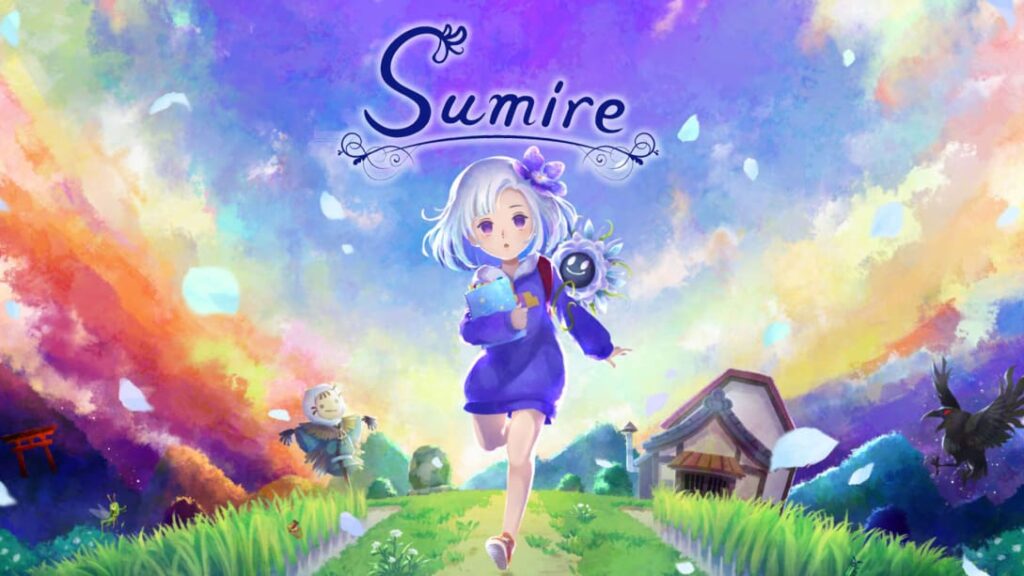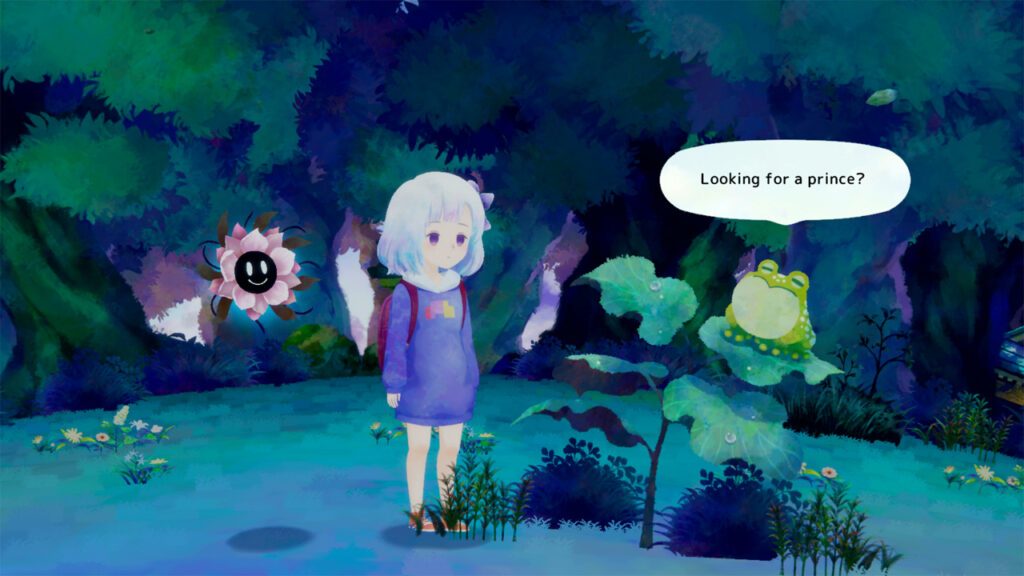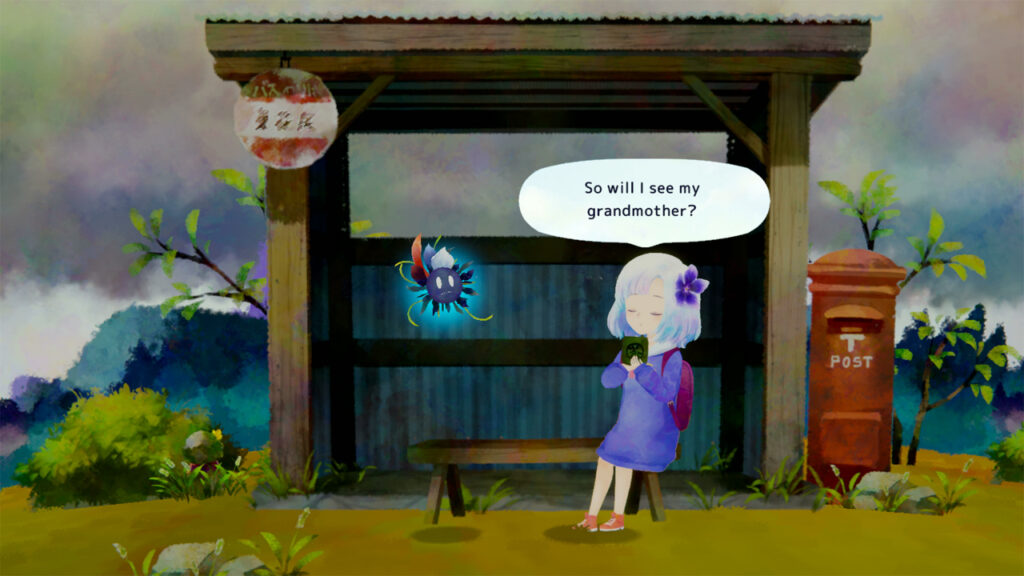
Developer: GameTomo
Publisher: GameTomo
Platform: Switch, PC
Tested on: Switch
Sumire – Review
One should never judge a book by its cover, as the saying goes, but sometimes a cover is so enticing that you can’t help but give a book a try. The same applies to Sumire, a game that completely draws you in with gorgeous watercolour art. The game certainly ticks the box when it comes to its aesthetics, but does it deliver on gameplay and storytelling as well? We took a deeper look at Sumire, and this is what we found.
Story
Sumire offers up a surprisingly touching and heartfelt narrative that feels like it could have come straight from the mind of Hayao Miyazaki. The titular Sumire is a young girl that is going through a very difficult time in her life. Her beloved grandmother passed away recently, and her parents have separated, causing Sumire’s mother to become depressed. This has led Sumire herself to become disillusioned with life. It’s clear that she’s going through a lot, and that she is feeling very lonely. Things change, however, when a mischievous spirit named Flower enters her life unexpectedly. Flower presents Sumire with an enticing offer. The spirit is only on earth for a single day. If Sumire aids Flower in making this day a joyful experience, then the spirit will grant the girl her biggest wish: to hear grandmother’s final message to her. It’s an interesting premise that is set up within the first few minutes, and although the game is a fairly short affair, it manages to cram in an incredible journey filled with memorable characters and touching moments without feeling cramped. We also challenge anyone that plays through Sumire to keep their eyes dry when they see the ending for the first time. While you probably won’t be bawling your eyes out, it is very likely that you’ll still shed a tear or two.
Graphics
The game’s striking visual style is one of Sumire’s most enticing elements. The pastel-tinted watercolor art style is simply gorgeous and there will be plenty of moments where you simply stop playing for a while to admire the game’s beautiful artwork. This is especially so with the full-screen art that fills up the screen during important story moments, but there are several jaw-dropping moments during gameplay sections as well. One of the more striking elements is that the game’s horizon is curved, rather than straight, which adds a unique feeling to the backdrops that further drives home that Sumire‘s visuals are something special. That’s not to say that these visuals are perfect, however. Character animations aren’t always up to par with the game’s aesthetics, with movement often feeling slightly wooden. Menus, such as shop interfaces, are ugly and clash with the rest of the game. It’s a bit of a shame that these lesser elements are present, because when Sumire’s visuals do work, they are eye-wateringly beautiful.
Sound
With a touching story and a soothing art style, you’d expect a matching soundtrack, and Sumire certainly delivers on this front. The music conveys the right emotions at the right time, with dramatic shifts during the more intense moments in the story. For the most part, the tunes that accompany Sumire on her journey are relaxing, with soft acoustic guitar tunes. There is no voice acting present, but this is one of those rare occasions where the lack of audible voices isn’t a deterrent, as it emphasizes the storybook-like nature of the game.
Gameplay
Sumire offers up a narrative-driven adventure game that focuses on completing simple tasks in order to progress the overarching story. The ultimate goal of the game is to present Flower with a fantastic day, so Sumire can hear her grandmother’s final message. Near the beginning of the game, the pair makes a checklist of tasks that Sumire has to complete in order to achieve this lofty goal. The checklist mainly acts as a framework around which the events that happen in the game are built, but it also serves as a handy in-game companion to keep track of what you’ve done and what you still need to do. It is far from a complete summary of what Sumire can do, however, as you’ll run into a variety of side characters, many of whom have requests as well. One such character is a cat that wants a bell-shaped flower and who will reward you with a real bell in return, which you can then use for another task. Sidequests are mostly simple fetch quests, and they occasionally chain together. Completing them is completely optional, although they’ll make progressing through the core game easier as you’ll not only earn items but coins as well. You can spend your coins in the game’s shops and buy items necessary to complete quests for the main storyline as well as for sidequests. Coins can be earned in other ways as well, such as picking them up from glowing spots on the ground.
The story branches depending on the choices you make. Most of these choices are simply a matter of deciding whether or not you are willing to help a character. These events can be time-sensitive, such as with a scarecrow, who is eager to remind you that you need to complete his request by noon. Given that the game only comprises a single day, and it’s easy to get distracted, it’s surprisingly easy to lose track of the sidequests that you still need to complete. The result is that an emotional component comes into play when you need to decide if you’re going to take on a request or not, as the characters are very relatable, and it can be a bummer if you break your promise to them. This component also comes into play when you need to make morally questionable decisions as well. One of the game’s earliest choices is a good example of this: near the beginning of the game, Sumire can choose whether or not to steal money from her mother’s purse. Taking the money gives the girl a massive advantage in the early stages of the game, but it does come with the realization that you’ve done a bad thing, which might come back to haunt you later in the game.
Although Sumire is light on gameplay, and mainly relies on its narrative experience to engage the player, the game still manages to insert enough interactive elements to make it feel like it is a game and not a glorified visual novel. Chief among these are the encounters Sumire has with a murder of crows that try to stop her quest. Sumire faces off against the birds in a variety of ways, ranging from having to sneak past them when they aren’t watching to dodging them as they try to assault her from the air. The encounters are never difficult to overcome, but they do shake things up. Another form of diversion comes in the form of mini-games that are implemented naturally throughout the story. While there isn’t a single mini-game that particularly stands out, they’re all fun little distractions that aid with the game’s longevity. There is a decent degree of replayability present as well, thanks to the branching story that deviates depending on the choices Sumire makes.
Conclusion
Although Sumire offers up slightly less engaging gameplay than we would have liked, it more than makes up for that through its storytelling and aesthetics. The game manages to convey an incredible amount of emotion through its narrative. Admittedly, there are a few rough edges here and there, such as with the stilted movement animations, but we’re really nitpicking here. Sumire’s journey is a fantastic one, that you’ll want to revisit over and over again. Picking up this game should be a no-brainer.
Sumire - Review,








No Comments